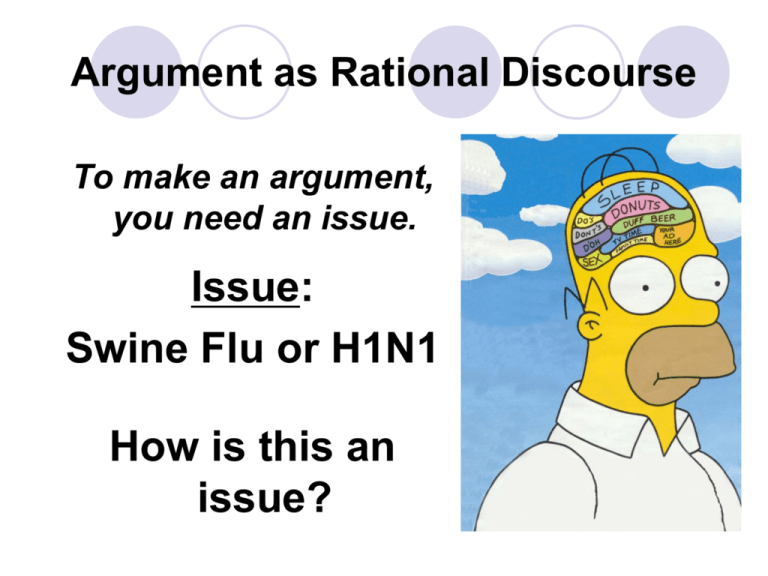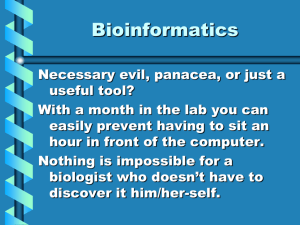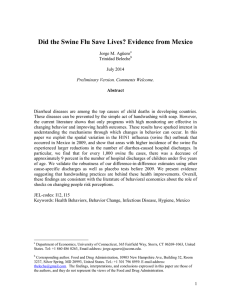Argument as Rational Discourse
advertisement

Argument as Rational Discourse To make an argument, you need an issue. Issue: Swine Flu or H1N1 How is this an issue? To get to the heart of an issue, you need a question at issue. Question at issue: Is the media exploiting H1N1 (formerly known as Swine Flu)? Form a Question at Issue for the following Topics Global Warming / Climate Change Teen Pregnancy Gay Marriage The Economy President Obama Technology: MySpace / Facebook / Twittering / Sexting Your Generation Drugs War on Terrorism Prisons Illegal Immigration Bush Administration Torture Relationship of Question at Issue to Claim (Thesis) Question at Issue: Is the media exploiting H1N1 (formerly known as Swine Flu)? Your Claim: The media is exploiting H1N1. Or The media is not exploiting N1N1 Or? Employing the Rogerian Strategy from Issue to Strategy Carl H. Rogers (1902-1987), best known for his book On Becoming a Person, was a psychotherapist, not a writer. Rogers: “When we do not listen, we do not grow.” To avoid this lack of opportunity for growth, the Rogerian Strategy requires participants in arguments to become partners, not adversaries. Rogers points out “when we engage in an argument, if we feel that our integrity or our identity is threatened, we stiffen our resistance” (Stubbs 66). Our opponent may have given good reasons, but because of his or her aggressive or even threatening approach, we may not be open to them. Consequently, an opportunity to gain knowledge—to grow—is lost. If we view argument as dialogue, an open exchange of ideas directed toward mutual understanding, we may find a more responsive audience and thus have a greater success with changing people’s opinions. Manipulation? Consider how you respond to people who seem to have a well-rounded, informed opinion. What happens to their ethos? Empathy is the keyword As Rogers suggests, the writer should “see the expressed idea and attitude from the other person’s point of view, to sense how it feels to him, to achieve his frame of reference in regard to the thing he is talking about.” How would Carl Rogers break up a bar fight? Writers generally interested in persuading others will educate themselves, by listening and reading. This is a path to wisdom. By employing the Rogerian Strategy: one can show sympathetic understanding of the opposing argument; one can recognize what is valid in it; one can recognize and demonstrate that those who take the other side are nonetheless persons of goodwill (or at least present themselves this way). Therefore, the Rogerian Argument is non-confrontational, collegial, and friendly; respects other views and allows for plural truths; And seeks to achieve some degree of assent (agreement) rather than convince utterly. The Rogerian Strategy: A Typical Outline 1. It usually begins by exploring common ground the writer shares with the audience—gains the interests from parties on both sides of the issue. Think of the basic human values the two sides might share. For example, for the issue of H1N1, health concerns about a pandemic is good common ground. 2. May move to some background information/ history on the issue, like the 1918 Influenza Pandemic that killed between 20 and 40 million people. 3. Moves towards an objectively phrased statement that defines the issue. For example: While some people feel as though the H1N1 Flu (Swine Flu) should be a major concern to all of us, others feel as though it is yet another example of our out of control media. 4. Presents a Question at Issue. For example: Is the media exploiting the H1N1 situation? 5. Presents a complete and neutrally worded analysis of one side’s position. You should demonstrate that you understand their position and their reasons for holding it. You should carefully avoid any suggestion that this position is more just, more moral, or more sensitive than the opposing position. 6. Presents a complete and neutrally worded analysis of the other side’s position. You should demonstrate that you understand their position and their reasons for holding it. You should carefully avoid any suggestion that this position is more just, more moral, or more sensitive than the opposing position—even though the second side presented is typically the author’s position (although your position may be a synthesis of the two, or something entirely new). 7. An analysis of what the two positions have in common and what goals and values they share. This discussion should be more specific than the common ground used to engage the two sides (see #1). Both sides in our example share concern about this specific flu pandemic, public health, and our ability to receive accurate information from the media. What else? 8. A presentation of your position—your claim (thesis, key assertion, conclusion). You cannot be neutral here. This is where you weigh in; however, remain consistent with the Rogerian style—this is not your time to “attack” the opponent, but rather your time to point out why your side will benefit all. Your position may align with one of the sides presented; it may be a synthesis of the two sides; or it may be an additional “side.” Remember, there are more than two sides to every issue. For example: While a flu pandemic is certainly something we should be prepared for, it is important to look at the recent history of the media and the corporations behind it to fully understand how they benefit from exploiting H1N1. Fear is known to… Current Issues via Editorial Cartoons Identify a Question at Issue





